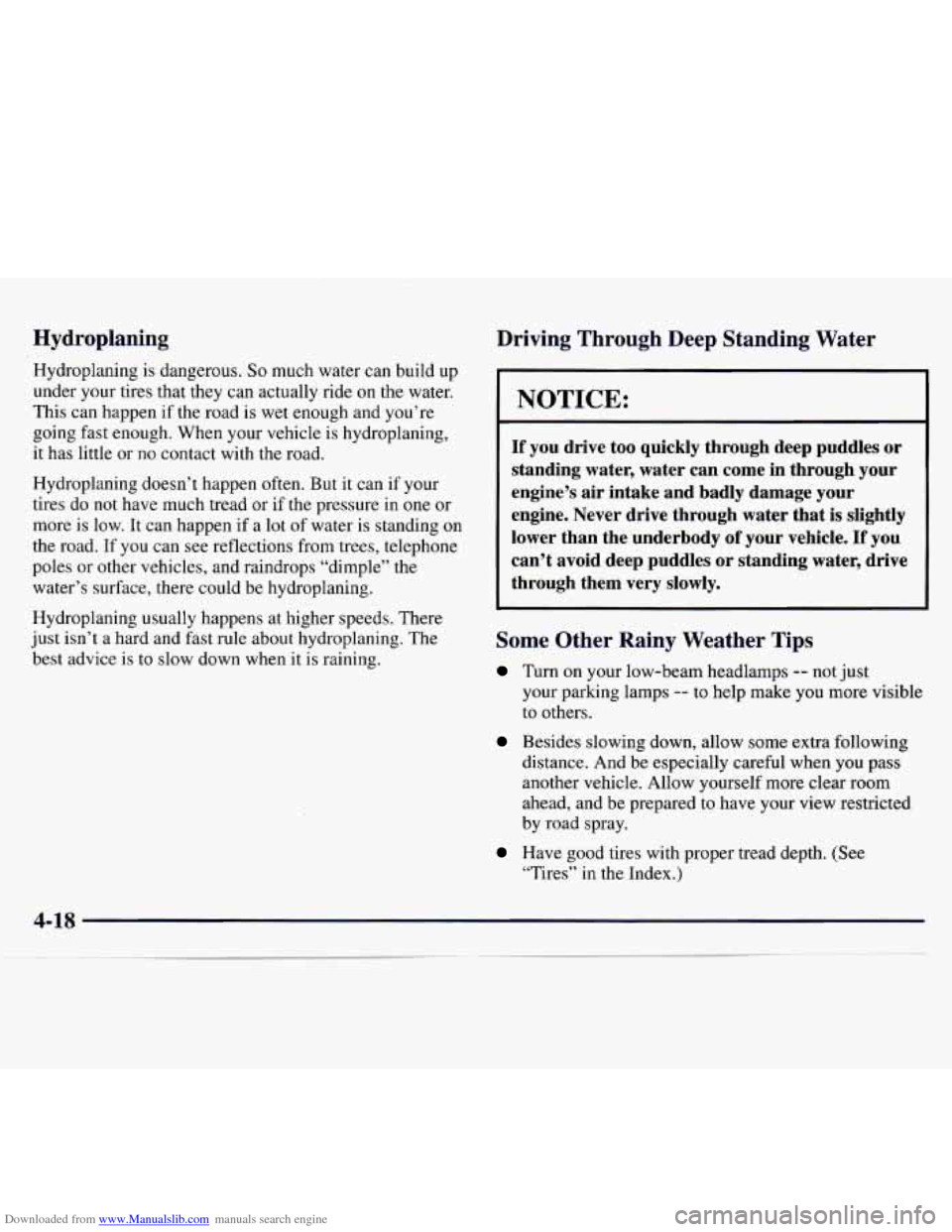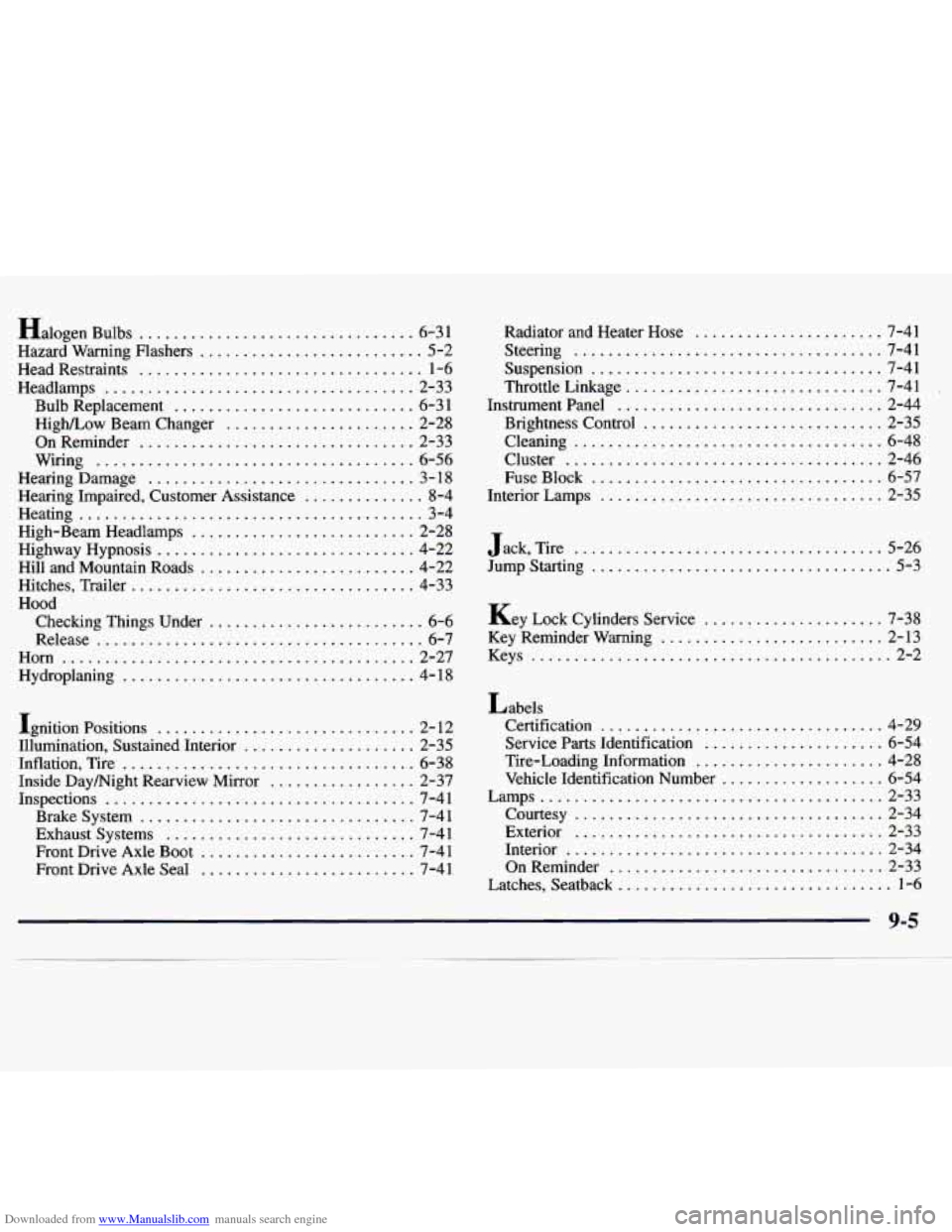1997 CHEVROLET MONTE CARLO high beam
[x] Cancel search: high beamPage 10 of 358

Downloaded from www.Manualslib.com manuals search engine Supplement to the 1997 Chevrolet Lumina and Monte Carlo Owner’s Manuals
This is a correction to information found on page 2-34 and 2-35 (Lumina) and page 2-34 (Monte Carlo).
Daytime Running Lamps / Automatic
Headlamp Control
Daytime Running Lamps (DRL) can make it easier
for others to
see the front of your vehicle during the
day. DRL can be helpful in
many different dnving
conditions, but they can be especially helpful in the
short periods after dawn and before sunset.
A light sensor on top of the instrument panel makes
the DRL work,
so be sure it isn’t covered.
The DRL system will make your high-beam headlamps
come on at a reduced brightness when:
The ignition is on,
The headlamp switch is off and
The parking brake is released.
97LUMWCARL0001 When
the DRL
are on, only your reduced intensity
high-beam headlamps will be on. The taillamps,
sidemarker and other lamps won’t be on. Your
instrument panel won’t be
lit up either.
When it’s dark enough outside, your DRL will turn off
and your low-beam headlamps will turn on. The other
lamps that come on with your headlamps will also
come on.
When it’s bright enough outside, the low-beam
headlamps will go out and DRL turns on your
high-beam headlamps at reduced intensity.
To idle your vehicle with the DRL off, set the parking
brake while the ignition is in
OFF or LOCK. Then start
your vehicle. The DRL will stay off until you release
the parking brake.
As with any vehicle, you should turn on the regular
headlamp system when you need it.
1
Page 86 of 358

Downloaded from www.Manualslib.com manuals search engine To stop the window while it is lowering, press the top of
the switch. To raise the window, press and hold the top
of the switch.
Horn
Press on or along the top edge of your steering wheel
horn symbols
to sound the horn.
Tilt Steering Wheel
A tilt steering wheel allows
you to adjust the steering
wheel before
you drive. You
can also raise it
to the
highest level to give your
legs more room when
you
exit and enter the vehicle.
To tilt the wheel, hold the steering wheel and pull the
lever
as pictured. Move the steering wheel to a
comfortable level, then release the lever to lock the
wheel in place.
hrn SignaVMultifunction Lever
I
a
The lever on the left side of the steering column
includes your:
0 Turn Signal and Lane Change Indicator
0 Headlamp HighLow Beam
Windshield Wipers
0 Windshield Washer
0 Cruise Control (Option)
Page 87 of 358

Downloaded from www.Manualslib.com manuals search engine lhrn Signal and Lane Change Indicator
The turn signal has two upward (for right) and two
downward (for left) positions. These positions allow you
to signal a turn or a lane change.
To signal a turn, move the lever all the way up or down.
When the turn is finished, the lever will return
automatically.
An arrow on the instrument
panel will flash in the
direction of the turn or
lane change.
To signal a lane change, just raise or lower the lever
until the arrow starts to flash. Hold
it there until you
complete your lane change. The lever will return by
itself when you release it.
As you signal a turn or a lane change, if the arrow
flashes faster than normal, a signal bulb may be burned
out and other drivers won’t see your turn signal.
If a bulb is burned out, replace it to help avoid an
accident. If the arrows don’t go
on at all when you
signal a turn, check for burned-out bulbs and check the
fuse (see “Fuses and Circuit Breakers” in the Index).
Headlamp HighlLow Beam
To change your headlamps
from low beam to high
beam, or high to low, pull
the multifunction lever all
the way toward you. Then
release it. When the high
beams
are on, a light on the
instrument panel also will
be on.
Page 154 of 358

Downloaded from www.Manualslib.com manuals search engine Here are some tips on night driving.
0
0
0
0
0
0
0
Drive defensively.
Don’t drink and drive.
Adjust your inside rearview mirror to reduce the
glare from headlamps behind
you.
Since you can’t see as well, you may need to
slow down and keep more space between you and
other vehicles.
Slow down, especially on higher speed roads. Your
headlamps can light up only
so much road ahead.
In remote areas, watch for animals.
If you’re tired, pull off the road in a safe place
and rest.
Night Vision
No one can see as well at night as in the daytime. But as
we get older these differences increase.
A 50-year-old
driver may require at least twice as much light to see the
same thing at night as a 20-year-old.
What you do in the daytime can also affect your night
vision. For example,
if you spend the day in bright
sunshine you are wise to wear sunglasses. Your eyes will
have less trouble adjusting to night. But
if you’re
driving, don’t wear sunglasses at night. They may cut down
on glare
from headlamps, but they also make a lot
of things invisible.
You can be temporarily blinded by approaching
headlamps. It can take a second or two, or even several
seconds, for your eyes to readjust to the dark. When you
are faced with severe glare (as from a driver who
doesn’t lower the high beams, or a vehicle with
misaimed headlamps), slow down a little. Avoid staring
directly into the approaching headlamps.
Keep your windshield and all the glass on your vehicle
clean
-- inside and out. Glare at night is made much
worse by dirt
on the glass. Even the inside of the glass
can build up a film caused by dust. Dirty glass makes
lights dazzle and flash more than clean glass would,
making the pupils of your eyes contract repeatedly.
Remember that your headlamps light up far
less of a
roadway when
you are in a turn or curve. Keep your
eyes moving; that way, it’s easier to pick out dimly
lighted objects. Just as your headlamps should be
checked regularly for proper aim,
so should your eyes
be examined regularly. Some drivers suffer from night
blindness
-- the inability to see in dim light -- and
aren’t even aware of
it.
4-15
Page 157 of 358

Downloaded from www.Manualslib.com manuals search engine Hydroplaning
Hydroplaning is dangerous. So much water can build up
under your tires that they can actually ride on the water.
This can happen if the road is wet enough and you’re
going fast enough. When your vehicle is hydroplaning,
it
has little or no contact with the road.
Hydroplaning doesn’t happen often. But it can if your
tires do not have much tread or if the pressure in one or
more
is low. It can happen if a lot of water is standing on
the road. If you can see reflections from trees, telephone
poles
or other vehicles, and raindrops “dimple” the
water’s surface, there could be hydroplaning.
Hydroplaning usually happens at higher speeds. There
just isn’t a hard and fast rule about hydroplaning. The
best advice is to slow down when it is raining.
Driving Through Deep Standing Water
NOTICE:
If you drive too quickly through deep puddles or
standing water, water can come in through your
engine’s air intake and badly damage your
engine. Never drive through water that is slightly
lower than the underbody
of your vehicle. If you
can’t avoid deep puddles or standing water, drive
through them very slowly.
Some Other Rainy Weather Tips
Turn on your low-beam headlamps -- not just
your parking lamps
-- to help make you more visible
to others.
Besides slowing down, allow some extra following
distance. And be especially careful when you pass
another vehicle. Allow yourself more clear room
ahead, and
be prepared to have your view restricted
by road spray.
“Tires” in the Index.)
Have good tires with proper tread depth. (See
Page 278 of 358

Downloaded from www.Manualslib.com manuals search engine Replacement Bulbs
Exterior Lamps Bulb Number
Back-up ......................... 3 156 or 3057
Center High-Mounted Stop
............... 891T2
Front ParkingiTurn Signal
............... 3357NA
Headlamp, High-Beam
................... 9005
Headlamp, Low-Beam
.................... 9006
Sidemarker, Front
......................... 194
Sidemarker, Rear
......................... 194
Stop/Tail/Turn Signal
..................... 3057
Interior Lamps Bulb Number
Dome ............................. 10230955
*For service information
on these bulbs, contact your
Chevrolet dealer service department.
Capacities and Specifications
Please refer to “Recommended Fluids and Lubricants”
in
the Index for more information.
Automatic Transaxle
Pan Removal and Replacement ..... 7 quarts (6.7 L)
After Complete Overhaul
......... 10 quarts (9.5 L)
When drainingh-eplucing convertel; more fluid muy
be needed.
Cooling System Including Reservoir
3100 (Code M) .............. 11.6 quarts (10.94 L)
3.4L DOHC (Code
X) ........ 12.3 quarts (1 1.65 L)
Refrigerant (R-l34a),
Air Conditioning* ....... 1.88 pounds (0.85 kg)
Engine Crankcase - Oil and Filter Change
3100 (Code M) ................ 4.5 quarts (4.2 L)
3.4L DOHC (Code
X) .......... 5.5 quarts (5.2 L)
Windshield Wiper Blade Replacement
Length .................... 22 inches (559 mm)
Type
.................................. hook
Fuel Tank
3100 (Code M) .............. 16.6 gallons (62.8 L)
3.4L DOHC (Code
X) ........ 16.6 gallons (62.8 L)
*See “Air Conditioning Refrigerants” later in this section.
Note: All capacities are approximate. When adding,
be sure to
Jill to the approximate level, as
recommended in this manual. See “Recommended
Fluids and Lubricants” in the Index.
Page 350 of 358

Downloaded from www.Manualslib.com manuals search engine Halogen Bulbs ................................ 6-31
Hazard Warning Flashers
.......................... 5-2
Head Restraints
................................. 1-6
Headlamps
.................................... 2-33
Bulb Replacement
............................ 6-3 1
High/Low Beam Changer
...................... 2-28
OnReminder
................................ 2-33
Wiring
..................................... 6-56
Hearing Damage
............................... 3 - 18
Hearing Impaired, Customer Assistance
.............. 8-4
Heating
........................................ 3-4
High-BeamHeadlamps
.......................... 2-28
Highway Hypnosis
.............................. 4-22
HillandMountainRoads
......................... 4-22
Hitches, Trailer
................................. 4-33
Hood
Checking Things Under
......................... 6-6
Release
...................................... 6-7
Horn
......................................... 2-27
Hydroplaning
.................................. 4-18
Ignition Positions
.............................. 2. 12
Illumination. Sustained Interior
.................... 2-35
Inflation. Tire
.................................. 6-38
Inside Daymight Rearview Mirror
................. 2-37
Inspections
.................................... 7-4 1
Brakesystem ................................ 7-41
Exhaust Systems
............................. 7-41
Front Drive Axle Boot
......................... 7-41
Front Drive Axle Seal
......................... 7-41 Radiator and Heater Hose
...................... 7-41
Steering
.................................... 7-41
Suspension
.................................. 7-41
Throttle Linkage
.............................. 7-41
InstrumentPanel
............................... 2-44
Brightness Control
............................ 2-35
Cleaning
.................................... 6-48
Cluster
..................................... 2-46
FuseBlock
.................................. 6-57
Interior Lamps
................................. 2-35
Jack. Tire
.................................... 5-26
Jump Starting
................................... 5-3
Key Lock Cylinders Service
..................... 7-38
Key Reminder Warning
.......................... 2-13
Keys
.......................................... 2-2
Labels Certification
................................. 4-29
Service Parts Identification
..................... 6-54
Tire-Loading Information
...................... 4-28
Vehicle Identification Number
................... 6-54
Lamps
........................................ 2-33
Courtesy
.................................... 2-34
Exterior
.................................... 2-33
Interior
..................................... 2-34
OnReminder
................................ 2-33
Latches. Seatback
................................ 1-6